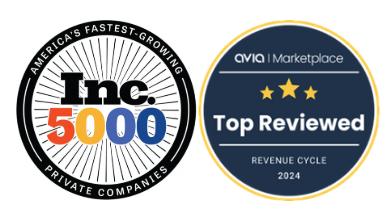As an Intelligent Automation SaaS Provider, we’ve built tried and true solutions to address pain points within your business. We understand the challenge and will apply best in breed technologies to successfully apply product solutions to you enhance your internal workflow.
%20(33).jpg?width=1584&name=Newsletter%20Template%20Images%20for%20Hubspot%20(1600%20%C3%97%20900%20px)%20(33).jpg)
April 2025 Vol. 57
Welcome to the latest edition of the CampTek Software newsletter, where innovation meets efficiency!
In this issue, we delve into the transformative power of intelligent automation and how our managed services are reshaping industries. Discover how our solutions are driving accuracy and efficiency in healthcare revenue cycle management, and learn about the scalable, reliable automation services that are setting new standards in the software industry. Stay informed with insights and updates that keep you at the forefront of technology.
CONTENT
- News
- Blog
- Prior Authorization
- Products
Additional Resources
Recent Blog Posts
Developing an AI Strategy within Revenue Cycle Management
Why Redundancy is Critical for an RPA/AI SaaS Company
Understanding the Difference Between Desktop Automation and AI
Top Case Studies
RCM Payment Posting Case Study
Revenue Cycle Prior Authorization Case Study
We're SOC 2 Type II Certified
CampTek Software Announces SOC 2 Type II and HIPAA Compliance

%20(32).jpg)
Check out this great article: 87% of IT leaders see AI agents as key to competitive advantage
" A Gartner study forecasts that by 2029, agentic AI will manage 80% of standard customer service inquiries independently, potentially reducing operational costs by 30%. Unlike earlier AI models focused on text generation, agentic AI is designed for task execution without human aid."


AI Needs a Partner: Why RPA Is Still Essential for Accessing EHR Data in Healthcare
We’ve all heard it—AI is going to revolutionize healthcare. It’ll predict diagnoses, optimize billing, streamline prior auths, and even tell your doc when it’s time to refill your prescriptions.
Sounds great, right?
But here’s the kicker most folks don’t talk about: AI, for all its hype, still has a major blind spot—it can’t access the data it needs from EHRs without a little help.
Let’s unpack that.
The EHR Problem Nobody Wants to Talk About
Electronic Health Records (EHRs) are a goldmine of clinical information. But they weren’t built for open access or easy integration. Most are heavily siloed, filled with proprietary logic, and sitting behind interfaces that are... well, let’s just say less than friendly.
APIs? Limited and expensive. HL7/FHIR? Great in theory, but a mess in practice—especially when you're dealing with older or customized systems.
So, what’s an AI supposed to do when it needs to pull in a patient’s chart, analyze treatment history, and spit out a recommended care pathway?
It can’t—not without something (or someone) doing the heavy lifting to get that data first.
Enter RPA: The AI Whisperer
This is where Robotic Process Automation (RPA) steps in. We like to think of RPA as the hands and eyes for AI in the healthcare space.
Let me give you a real-world example: one of our clients wanted to use a machine learning model to predict prior auth denials. Smart idea—but the model needed access to real patient data to train itself. The problem? That data lived inside 4 different EHRs, all with different UIs, login protocols, and workflows.
Did the AI figure it out on its own?
Of course not. We deployed attended and unattended bots that could log into each system, extract structured and unstructured data (think demographics, CPT codes, previous denial reasons), and send it to a central repository for the AI to work its magic.
Without RPA, that AI would still be twiddling its thumbs, waiting for someone to hand it the data on a silver platter.
AI + RPA = Healthcare Harmony
Here’s the deal: AI is only as good as the data it’s fed. And in healthcare, that data is often locked away behind 8 different clicks, a Citrix session, and a 3-minute load time.
RPA doesn’t care. It’ll wait. It’ll click. It’ll extract and validate.
Better yet, it’ll do it 24/7, error-free, and at scale.
Now we’re seeing powerful AI solutions emerge—not because they magically integrate with EHRs, but because RPA made the introduction.
Looking Ahead
Healthcare orgs are rushing to adopt AI, and rightly so. But the ones seeing the best results? They’re the ones who realize that RPA isn’t just a stopgap—it’s a strategic partner.
AI might be the brain. But RPA? It’s the body that gets the job done.
So next time someone tells you AI is the future of healthcare, smile and nod. Then tell them it’s RPA that’s quietly doing the work behind the scenes.
Want to see how AI and RPA can work together in your healthcare organization? Drop us a line—we’ve done it before, and we’re ready to help you do it too.
Written by: Mihai Cerbu, CTO
%20(4).jpg)
%20(23).jpg)
Prior Authorization
A few facts about the current State of Prior Authorization in the U.S. Healthcare market.
- Over a quarter (27%) of prior authorizations are often or always denied by insurance companies.
- Request and Statusing Delays: These can result in missed timeline requirements and financial losses, amounting to a 2-5% loss of topline revenue for healthcare providers.
- A majority of doctors (62%) said prior authorization has led to additional office visits, with 64% saying authorization hassles have led to ineffective initial treatments. Nearly half of physicians (46%) said prior authorization has resulted in patients needing immediate care, including emergency department visits.
- $35 Billion is spent in the US each year on administrative costs for Prior Authorization
- There is an average of 300k changes to a Payors health plan per year.
Recent study indicated that the use of light AI and RPA went from 10% approval to 90% approval improvement
The CampTek Prior Authorization AI Automation solution uses a multi-pronged approach to solve the myriads of challenges presented by submitting Authorizations in an accurate, timely and successful way.
Our solution is composed of several parts:
- Automation and AI First. Using AI, we can take a historical view of the 835 files from your top Payors to identify high level trends around denials by Payor, CPT code, Diagnosis, physician and patient demographics.
Using this data, we build Prior Authorization Automations that perform both the Request and Status parts of the workflow. Our data team begins to pull the data from the automations to feed the AI Model.
These automations are bespoke and will work any EMR, Payor Portal, Availity, Waystar or other clearing houses. See examples of the Prior Auth Request and Status Bots running in action. - Intelligence Building. Once the automations are running in production, we begin gather data an intelligence around the authorizations that are getting statused, this data will be fed to the data model continuously. In addition, any changes in the Payors plan that are communicated via their website, pdfs or other forms are also fed to the data model to make the AI more intelligent.
- Intelligence Consumption. This approach, in time, will provide incredible value in that it can react and adapt to Payor changes but also ensure that the Prior Authorization submitted will be completed and have a higher chance of acceptance. The outcome will be capturing lost top line revenue and providing specific inhouse intelligence for Prior Authorization using predictive, generative and analytic AI intelligence. This can be consumed in a platform independent way (agentic AI Bots, data analytics programs, ChatBots, Epic or other applications that have API integration).
This is a feed and use the “brain” approach all while giving an operations team the tools it needs to be efficient, save on costs and capture the revenue that would otherwise be written off. Payors are increasingly using AI, so this is a crucial strategy for Providers to have this on their roadmap.

%20(21).jpg)
